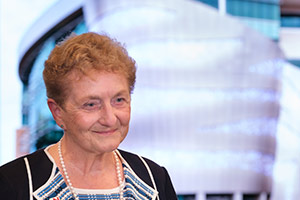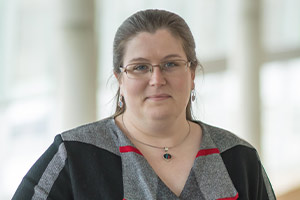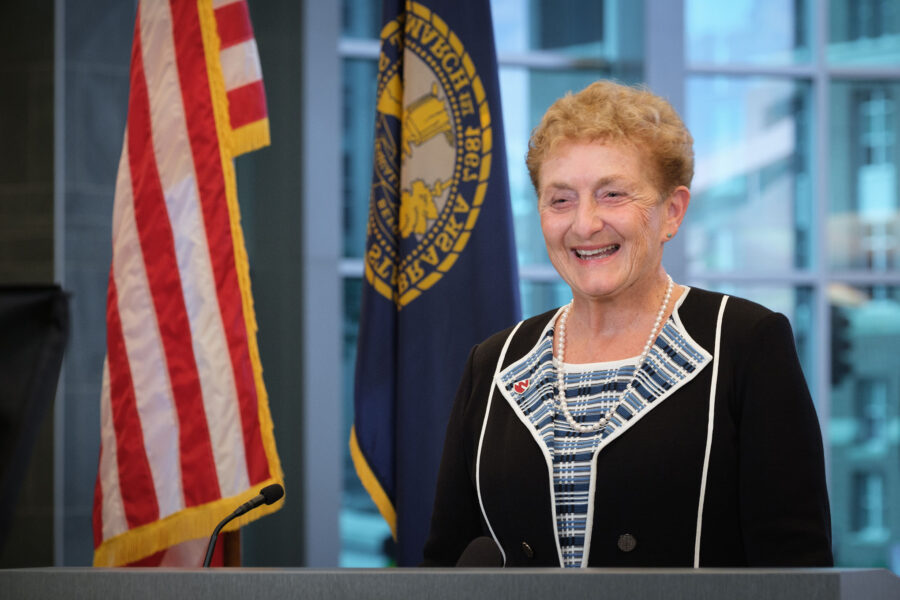UNMC and Pamela Boyers, PhD, associate vice chancellor of clinical simulation, iEXCEL, were recently highlighted as part of the University of Nebraska System’s NU for NE campaign, which shares stories of outstanding faculty, staff and student work across the campuses and ways that NU is helping to strengthen Nebraska’s workforce.
Pamela Boyers is a warm person. Her soft British accent puts you at ease, and she sounds both highly capable and welcoming at the same time. She came of age in the U.K. health care system, training as a nurse in London. As she saw the stress that both nurses and doctors were under — and observed how that impacted patients — Dr. Boyers decided to learn more about human behavior, psychology and how human performance affects patient care.
“I’ve had the opportunity to counsel physicians and their families, working with them to get through whatever stresses and strains they were experiencing,” she said.
Her work in behavioral medicine led her to teach in the U.S., where she received her master’s and doctoral degrees in counseling and education at The Ohio State University.

Dr. Boyers saw health care as a team effort, rather than the work of numerous individuals, and began to focus on interprofessional learning — how training and clinical care happens within the larger health care team. She also began to focus on the advantages of simulation, where clinical skills are learned through repeated practice. The question driving her: How do you ensure that health care education is relevant for modern medical practice?
Today, she serves as associate vice chancellor of clinical simulation at iEXCEL, a center at UNMC that enables students to learn and practice professional clinical skills using a wide variety of simulation techniques — before encountering real-life situations. Dr. Boyers has opened four such centers across the nation, but this one is seen as the crown jewel.
“Simulation is the way of the future,” Dr. Boyers said. “This extraordinary center provides a safe place for health care professionals — at any level of training, in any discipline — to practice and hone their skills so they can provide the best possible patient care.”
Safe, Innovative Teaching Environments
What does medical simulation look like? And more importantly, why is it needed?
A Johns Hopkins study has calculated that more than 250,000 deaths per year occur due to medical error — making it the third leading cause of death in the U.S. Most hospital errors involve breakdown in processes and can include delays in diagnostics and information flow, poor communication between teams and issues with hand-offs as a patient moves through the levels of care.
“The investment that Nebraska has made in next-generation clinical learning is going to serve the state, the nation and the world.”
—Pamela Boyers, PhD
Calls for change in instructional methods have resulted in curricula that stress the importance of proficiency in clinical skills. Many students graduate from health care professions armed with theoretical knowledge — but without sufficient opportunity to practice enough. Practice ensures proficiency and develops confidence in the clinical skills that are critical to their work.
iEXCEL aims to change the paradigm of how students learn.
“The Davis Global Center — which houses iEXCEL — is purposefully designed for students to build confidence and ensure they are not learning how to do procedures on live patients. When you talk to doctors and nurses, one of their biggest fears is hurting a patient,” Dr. Boyers said. “We keep an eye on advancing technologies, which helps us create realistic simulation experiences for our health care students. At the end of the day, the investment that Nebraska has made in next-generation clinical learning is going to serve the state, the nation and the world.”
If you are a medical, nursing, public health, pharmacy or allied health student learning at iEXCEL, you are learning with some of the best simulation and visualization technologies that exist today.
iEXCEL’s holographic theatre, the first in any academic institution in the world, transforms learning with immersive lectures that use 3D holographic content. As faculty members teach, 3D images of organs rotate besides them, bringing their points to life.
Large, interactive touchwalls incorporate video, graphics and visualization to create an advanced learning environment. They also help groups to collaborate and learn as teams. The walls are connected to UNMC’s training sites across Nebraska, allowing students to interact in real-time.
iEXCEL’s Laser Cave uses a five-sided space to give students a full-body experience involving sight, sound, physical movement and interaction. You might put on a pair of VR glasses and dive deep into the body, observing what happens when a stent and balloon is put into a vein — as if you were inside the body itself.
These technologies help learners and researchers visualize and understand difficult concepts and envision new solutions. And that’s just some of the visualization capabilities.

iEXCEL also has powerful simulation capabilities. The Davis Global Center houses a replica of a total health care system, starting with an apartment where students can recreate patients transferring from home to the hospital and back again after discharge.
“We call this our simulated community care floor,” Dr. Boyers said. “It contains a home care unit that allows students to train in emergency responses and home safety evaluation and a separate ambulance bay where we practice transporting patients to the hospital.”
There is also a floor that recreates an entire hospital, with multiple care units — including pediatrics, critical care, labor and delivery and a trauma suite. These areas are used to simulate patient care scenarios that help students practice what to do in a wide variety of incidents and events, from delivering babies to responding to codes. Students and faculty pre-brief and debrief before and after practice sessions, reviewing recorded sessions and breaking down what went well and what they could improve the next time around.
Lastly, the center has a surgical floor that replicates 20 operating room bays. This area allows advanced surgical skills training, using fresh tissue and surgical simulators. The metal operating tables gleam under the bright lights, where students practice and improve skills including hand-eye coordination, depth perception and suturing.
“My goal is to get students as clinically ready as possible for what’s coming. We use simulation very heavily in this setting — to give them as many touches on what they’re going to be doing for real patients.”
—Amy Cutright, MD
Impacting Teaching and Learning
Amy Cutright, MD, is a professor in the UNMC Department of Emergency Medicine and an emergency room physician at Nebraska Medicine. She teaches several classes at iEXCEL, including an acute care and clinical transitions course where students learn in simulated environments that help build confidence.
Dr. Cutright is focused on training medical students with top-notch clinical proficiency. This means her students practice clinical skills over and over again, using simulations that are low-risk and focused on collaboration. One day, a group of students may be practicing suturing. Another day, they may be putting in IVs.
“The more comfortable medical students are in their environment, the more they can engage with the patient, participate in patient care activities and advance their clinical learning — which is very different than learning in a classroom environment,” Dr. Cutright said.
Simulation is helpful for student learners because it allows them the leeway to make mistakes.
“Historically, medical students completed their first medical history and physical on a real-life patient with complaints,” Dr. Cutwright said. “Now, they see six patients in a simulated environment before they see a live patient. They do six histories, six physical exams, six sets of notes, six presentations. They learn to be uncomfortable in a situation where they don’t know everything — but they get there eventually, with enough exposure and repetition.”

Students appreciate the opportunity to practice their clinical skills before they’re in a clinical environment. Grace Kelly is a second-year medical student taking Dr. Cutright’s acute care and clinical transitions course. She describes their simulation training as a four-week boot camp before students start their first round of clinicals.
“Simulation is amazing because it takes the pressure off. You get to practice necessary medical skills, which prepare you for working with an actual patient,” Kelly said.
She believes it’s critical for medical students to develop confidence.
“When medical students go into our clinicals confident, we’re able to make better decisions — we’re not questioning everything we’re doing. We’re more efficient, more timely.”
Kelly and her classmates practice on both low- and high-fidelity manikins. Low-fidelity manikins include intravenous insertion arms and CPR dolls, which teach the basics of technical skills. High-fidelity manikins can be full-body and more closely resemble reality; they are able to breathe, blink, emit fluids and respond to physical or pharmacological interventions.
“Simulation is amazing because it takes the pressure off. You get to practice necessary medical skills, which prepare you for working with an actual patient.”
—Grace Kelly, second year UNMC medical student
Medical students also may work with standardized patients — an individual trained to act as a real patient and simulate a set of symptoms or problems. Kelly described doing ultrasound simulations:
“We would watch videos on how a professional does ultrasounds; then we would come in the next day and complete them on standardized patients. The hands-on experience helped me gain more clinical knowledge, and I was able to practice in a low-risk environment.”
Developing the Health Care Workforce
Ben Stobbe is the assistant vice chancellor for clinical simulation at iEXCEL. His background as a registered nurse gives him experience in the clinical world, and his MBA gives him expertise in the business world.
“There’s a cost to things in the real world,” Stobbe said.
As an example, when running a trauma simulation, students may pre-order x-rays, labs and other items that are standard trauma care — without first looking at the patient coming in and determining what tests are needed to provide initial treatment.
“They may not end up using 50% of the tests ordered during the trauma simulation. We try to build a financial awareness into the simulation, to develop a mindset that there’s a cost to deliver this care, and we should be efficient with our resources.”
“iEXCEL not only helps train health care students from all disciplines — it also upskills and trains current health care professionals.”
—Ben Stobbe
Stobbe explained that iEXCEL not only helps train health care students from all disciplines, it also upskills and trains current health care professionals. One example is a course offered by the UNMC College of Nursing, aimed at training current nurses to work in the operating room. The course includes simulation and builds skill sets that would be needed for a job transition into the OR.
“We can reduce the orientation time for these nurses, which helps get them working in the OR in a much faster timeframe.”
iEXCEL also helps Nebraska Medicine onboard their certified nursing assistants.
“Studies have shown that health care professionals sometimes leave their jobs when they don’t feel confident at the skill level they’re asked to perform,” Stobbe said. “Simulated training can help retain the health care workforce. It embeds them in realistic scenarios, allowing them to develop the skill set to provide safe patient care.”
“The airlines, the military, nuclear power, railroads — all these industries use simulation to improve safety, reduce costs and increase quality,” Dr. Boyers said. “What we’re doing in health care is based on lessons learned from other disciplines.”
“At the end of the day, it’s about the patients,” Stobbe said. “We’re using technology and innovation to help individuals become better patient care providers.”

Congratulations to Dr. Boyers and her fantastic iExcel Team!
Pam,
What an incredible facility and programs you have developed. Boggles my mind. Congratulations!
Carol Russell
A great legacy, Dr. Boyers. Congrats to you and your team on this groundbreaking achievement.